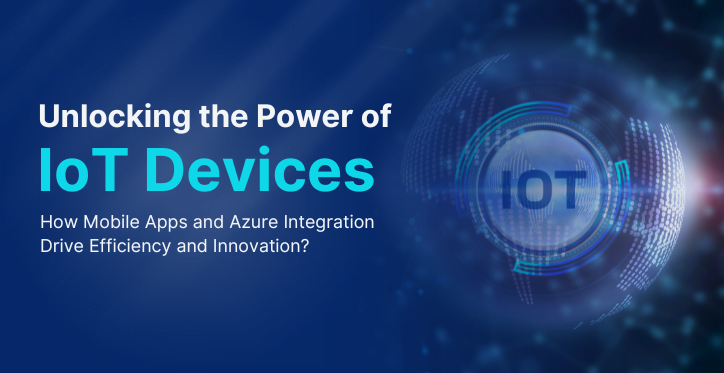Home » Unlocking the Power of IoT Devices: How Mobile Apps and Azure Integration Drive Efficiency and Innovation

Integrating IoT devices with mobile applications is becoming more critical for companies to succeed in the digital age. By facilitating data exchange and communication between both technologies, companies can get real-time information about their operations and make informed decisions based on data. Furthermore, mobile apps can serve as a central control point for IoT devices, allowing users to control and monitor different functions remotely. Let’s start reading about how Azure Integration is important for mobile apps.
Azure Integration of mobile applications together with IoT devices has opened new opportunities for both users and companies alike. Mobile apps allow users to manage and monitor devices on the go, while IoT devices provide real-time information regarding device usage and performance. They used data to optimize the performance of devices and enhance overall efficiency.
Mobile apps can control various IoT devices, such as smart thermostats and smart lighting. They also control smart cameras, smart locks, and smart home appliances. In addition, they can be controlled and monitored via a mobile app that gives users more ease of use and greater flexibility. Finally, we can say that IoT mobile app development becomes significantly more beneficial when leveraging the power of Azure integration.
For example, they can switch on and off their smart lighting, alter their thermostat, lock and unlock their smart doors, and monitor their security cameras remotely via an app on their mobile. In addition, users can manage and control their devices from any location at any time.
IoT mobile apps also offer live data about the performance and usage of devices, allowing users to maximize their use and reduce energy usage. For instance, users could track their energy consumption using apps on mobile devices and adjust their thermostats accordingly to lower energy consumption and cut their utility costs.
Apart from providing greater ease of use and greater flexibility for users, integrating mobile apps and IoT devices can also bring numerous benefits to businesses.
Companies can use the data provided by IoT devices to improve device performance and enhance overall efficiency. For instance, they can utilize real-time data about the device’s usage to detect patterns in the usage and adjust settings to match. This could lead to better performance of devices and higher efficiency.
Mobile app integration also gives businesses important insights into customers’ behavior and preferences. Businesses can, for instance, utilize data from mobile apps to study the patterns of customer use and preferences and adapt their products or services to satisfy their customers’ requirements better.
Get free Consultation and let us know your project idea to turn into an amazing digital product.
Mobile applications and IoT devices have transformed how we interact with technology. This SaaS application integration with Azure offers a variety of benefits for both users and businesses alike. This blog will look at the advantages of integrating mobile applications with IoT devices.
The benefits of integrating Mobile Apps with IoT Devices:
Azure integration of mobile applications with IoT devices can improve effectiveness by allowing users to manage the devices from afar. This means that they can power off and turn on their devices, alter their settings, and receive notifications without needing to engage with their devices physically. This can save time and energy, particularly when users have several devices.
In the case of businesses, using mobile applications with IoT devices can improve productivity by providing instant information regarding device use and performance. The data is utilized to optimize the performance of devices and increase overall efficiency.
In conjunction with IoT devices, mobile applications could enhance the user experience by offering users a more user-friendly and intuitive interface. In addition, mobile apps will make it easier to control and monitor the process of IoT devices, which makes it simpler for users to use them. This will lead to improved user satisfaction and the use of new technologies.
Companies using integrated mobile apps with IoT devices can enhance the user experience by offering customized services and suggestions. This will result in increased retention and loyalty of customers.
Azure Integration of mobile applications together with IoT devices can increase security and safety by allowing users to control and monitor their devices remotely. For instance, they can be notified when their devices fail to function or if there’s an incident of security. This lets users take necessary steps to avoid risks or security breaches.
For companies, integrating mobile apps and IoT devices can improve security and safety by supplying live data about device performance and security incidents. The information can be utilized to enhance security procedures and avoid potential dangers.
Azure integration with IoT mobile apps can result in greater savings for the business and the user. For consumers, monitor and remote controls of the devices may result in lower energy consumption and lower utility costs. Users can also save money on repairs and maintenance costs by monitoring their devices and addressing any issues that could arise before they become serious.
Companies using mobile applications with IoT devices could result in an increase in cost savings by improving the performance of devices and decreasing energy usage. This could result in lower operating costs and improved profits.
Azure Integration of mobile applications in conjunction with IoT devices will provide valuable analysis and information about device performance and usage. These data can be utilized to improve device performance and use. Businesses, for instance, can make use of this information to detect patterns in usage patterns and adjust settings to suit. This could lead to better device performance and efficiency.
IoT in mobile app development can offer useful insights into the usage of devices and their performance. Users can use this information to optimize their device’s usage and reduce energy usage. This could result in lower energy bills and better sustainability.
IoT-based mobile applications have changed our interaction with technology. But the process of Azure integration has its difficulties. This blog will discuss the challenges associated with connecting mobile apps to IoT devices and how to overcome these issues.
Compatibility is among the biggest challenges in Azure integrating mobile apps with IoT devices. With the number of available devices, it is not easy to make sure that mobile apps work with every one of them. This can cause users frustration and a need for more use of new technologies.
To avoid compatibility issues, developers should create standard protocols that can be used on all devices. Furthermore, these protocols must be open source and therefore be able to be used freely and modified by developers. This makes it much easier for IoT development companies to develop mobile applications that work with a variety of mobile devices.
Security is a major issue in integrating mobile IoT apps with Azure. IoT devices are usually linked to the web, which makes them vulnerable to cyber-attacks. Mobile apps are also susceptible to attack when they aren’t adequately secured.
To combat security concerns, Azure mobile app developers must focus on developing secure protocols to facilitate communication between mobile apps and IoT devices. This means encryption to safeguard information and using user authentication to stop unauthorized access. In addition, developers should stay informed about the latest security threats and adopt the best methods to secure mobile applications and IoT devices.
Data privacy is a major issue for Azure integration of mobile apps and IoT devices. IoT devices frequently collect and send sensitive data, including personal information and use patterns. If this information falls into improper hands, it can result in privacy breaches and even identity theft.
To combat the privacy issues associated with data, IoT application developers must concentrate on implementing secure protocols for data storage and transmission. This means using encryption to secure information during storage and transmission and user authentication to block unauthorized access. Developers should also present users with simple and clear privacy policies and seek permission before sending sensitive data.
The user experience is a significant problem when integrating mobile apps into IoT devices. The user interfaces for IoT devices are often complex, which makes it difficult for users to manage and manage the devices effectively. Mobile apps can offer a more straightforward user interface, but they need to be designed using the perspective of users.
To address user experience issues, Developers should concentrate on IoT software development that is easy to use and understand. This includes reducing the user interface and providing precise and easy instructions to control and monitor IoT devices. Developers must also conduct usability tests to ensure their mobile applications are simple to use and comprehend.
Power consumption can be a major issue for mobile apps and IoT devices. This is because IoT devices typically have a limited battery life, while mobile apps consume large quantities of power, consuming the battery faster.
To address power consumption issues, companies that offer IoT application development services must focus on developing energy-efficient mobile applications and IoT devices with Azure. This involves limiting energy-consuming features like GPS and Bluetooth and optimizing the code to reduce power consumption. In addition, mobile app developers should also look into using low-power wireless protocols like Zigbee or Z-Wave to decrease the power consumption of IoT devices.
Mobile apps’ future and IoT technology are exciting, with many advancements shortly.
Voice recognition technology has already migrated to our homes due to Amazon Echo and Google Home devices. We’ll likely find more mobile apps incorporating voice recognition technology, allowing users to manage their IoT devices hands-free.
Voice recognition technology makes users more comfortable managing their devices, specifically those with mobility problems. It could also make IoT devices more accessible to users. IoT devices are easier for users who need to gain technical skills.
Augmented Reality (AR) is a different technology poised to transform how we interact using IoT devices. AR overlays digital data onto the real world, allowing users to operate devices more naturally with the Internet of Things app development.
Imagine having the ability to connect your phone to the thermostat of your choice and make use of AR to alter the temperature. This type of technology makes controlling IoT equipment more natural and easier, especially for users who are struggling with traditional interfaces.
Artificial Intelligence (AI) is currently employed in numerous mobile phone and IoT applications. However, we are likely to see further advancements shortly. For example, AI could help make IoT devices more responsive and intelligent, allowing them to adjust to the user’s behavior and preferences.
For instance, a smart home could use AI to analyze the user’s habits and adjust temperature and lighting settings to match. This kind of technology can assist in making our homes more energy efficient and comfortable.
5G technology is expected to transform our way of connecting to the Internet, significantly impacting mobile applications and IoT devices. IoT app development companies use 5G which promises faster upload and download speeds, less latency, and more capacity, allowing more devices to be connected to the web.
In 5G networks, smartphone applications and IoT equipment will soon be able to communicate in real time, which opens new possibilities for automated control and automation.
Blockchain technology is a great way to enhance your security when using mobile apps and IoT devices. Blockchain is a decentralized ledger that can be utilized to store data securely. With the help of blockchain tech, smartphone applications, and IoT devices will ensure that data is securely stored and that users are in access to their data.
For instance, a smart home system can use blockchain application development to ensure that the user’s data is secure and encrypted and that only authorized users can access it.
The rapid growth of IoT (Internet of Things) devices and mobile apps has provided many possibilities for creativity and automation. However, the technical aspects of connecting the two technologies can take time and effort. This page will examine the technical aspects that play a role in connecting mobile applications and IoT devices.
One of the primary technical factors in creating connectivity between mobile phone applications and IoT gadgets is the selection to use an IoT protocol. IoT protocols define the communication standards that determine how IoT devices interact with one their counterparts and other systems, such as mobile apps. There are many IoT protocols to choose from, including MQTT, CoAP, and HTTP, each with distinct strengths and weaknesses.
The MQTT (Message Queuing Telemetry Transport) is a light messaging protocol extensively utilized in IoT applications. The purpose of this product is to provide fast and reliable service, making it an excellent choice for applications requiring minimal latency and high dependability. CoAP, also known as the Constrained Application Protocol, is a lightweight protocol designed explicitly for use when resources are limited. This makes it ideal for IoT devices. It’s created to be straightforward and is a good option for IoT applications.
HTTP is a trendy tool for web-based applications. However, it’s a much more complex method than MQTT and CoAP. However, it has many applications and uses in different contexts.
Another crucial technical aspect in Azure integration of mobile apps or IoT gadgets is the data format selection. The data format is the structure of data sent between the mobile application and an IoT device. There are a variety of designs for data, such as JSON, XML, and CSV.
JSON (JavaScript object notation) is a lightweight data format that is extensively utilized in web-based applications. It was made simple to write and read and thus is a great option for IoT applications. XML (eXtensible Markup Language) is a more complicated information format than JSON. However, it’s also more robust and can display more complex data structures. Finally, CSV (Comma-Separated Values) is a straightforward data format typically used to represent tabular data.
Security is crucial in creating connectivity between mobile applications and IoT devices. IoT devices are usually vulnerable to cyberattacks and must be adequately secured. There are a variety of security methods that can be utilized to protect IoT devices, such as encryption, authentication, and control of access.
Why use authentication in Azure integration? Authentication is the method that identifies the identity of the user or device. It’s used to block unauthorized access to IoT devices. It is the process of creating a form of data that is only accessible by authorized individuals. It’s used to stop unauthorized access to information transmitted between the mobile application and an IoT device. Controlling access limits users’ access to IoT devices depending on the role of the user or access rights.
Scalability is crucial in creating connectivity between mobile applications and IoT devices. It is crucial to have a scalable connectivity solution for IoT devices, considering they are commonly used in large quantities. Scalability is the solution’s capacity to support many users and devices without compromising performance.
There are various methods to ensure scalability, such as clustering, load balancing, or horizontal scaling. Load balancing consists of distributing network traffic over several servers or devices. Clustering involves placing multiple servers or appliances to work as one unit. Finally, horizontal scaling refers to adding more servers or devices to manage increasing network traffic.
The Internet of Things (IoT) is overgrowing, and its impact is evident across all sectors. Due to the rise in the number of connected devices, mobile apps that connect to IoT devices using Azure integration are becoming crucial for companies looking to remain ahead of the curve. However, developing an app that can communicate with IoT gadgets requires a different method compared to conventional mobile app development. Let us review the best practices to follow when creating an app that can communicate with IoT devices.
One of the first steps in creating an application that can connect with IoT gadgets is to learn how to navigate the IoT ecosystem. The IoT ecosystem is comprised of protocols, device gateways, and cloud-based platforms and applications. Understanding how these elements work together is essential for efficient IoT applications.
Equipment: IoT devices are sensors, actuators, and other intelligent devices that gather and send information.
Protocols IoT protocols define the standard for communication that describes how IoT devices communicate with one another and other systems.
Gateways IoT gateways can link IoT devices to the internet and other networks.
Cloud platforms offer infrastructure and tools to manage and analyze IoT data.
Application: IoT Applications are programs that run on the computer, interact with IoT devices, and use the data gathered by the devices.
Scalability is crucial in creating connectivity between mobile applications and IoT devices. It is crucial to have a scalable connectivity solution for IoT devices, considering they are commonly used in large quantities. Scalability is the solution’s capacity to support many users and devices without compromising performance.
The appropriate IoT protocol is crucial for creating an application that can communicate with IoT devices. A variety of IoT protocols are available, including MQTT, CoAP, and HTTP. Each protocol has its strengths and limitations, and the choice of the protocol will be based on the application’s specific requirements.
The MQTT (Message Queuing Telemetry Transport) is a light messaging protocol extensively utilized in IoT apps. It’s developed to be effective and reliable, making it an ideal option for applications that need minimal latency and high reliability.
CoAP (Constrained Application Protocol) is a different, lightweight protocol that is designed for use in situations with limited resources like IoT devices. It’s created to be straightforward and is a good option for IoT applications.
HTTP (Hypertext Transfer Protocol) is an established protocol that is extensively utilized in web-based applications. It’s a more complicated technique compared to MQTT and CoAP. However, it’s also more flexible and is used in many applications.
Choosing the best cloud platform is crucial for IoT and mobile app development. Cloud platforms offer tools and infrastructure to manage and analyze IoT data. There are a variety of cloud platforms, such as Microsoft Azure, Amazon Web Services (AWS), and Google Cloud Platform.
Microsoft Azure is a renowned popular cloud platform offering various solutions for analyzing and managing IoT data. It offers services like Azure IoT Hub, Azure IoT Edge, and Azure IoT Central. These include tools for managing, analyzing as well as processing IoT data.
AWS is another cloud platform that offers many different options for analyzing and managing IoT data. It provides services like AWS IoT Core, AWS IoT Analytics, and AWS Greengrass, which provide tools to analyze, manage as well as process IoT data.
Google Cloud Platform is a cloud platform that offers many different solutions for analyzing and managing IoT data. It provides services like Google Cloud IoT Core, Google Cloud Pub/Sub, and Google Cloud Functions, which offer tools to manage, analyze, and process IoT data.
A user-friendly interface is vital to develop an application that connects to IoT devices. The interface should be easy to navigate and user-friendly, allowing users to navigate the application effortlessly while interacting with IoT devices.
The app should feature an easy-to-read user interface with simple-to-understand images and descriptions. It should also be an aesthetically consistent layout across all devices.
Mobile applications and IoT devices have changed our interaction with technology. However, it has its problems. Developers need to address compatibility security, privacy, user experience, and power consumption issues to ensure the integration is successful. Mobile applications together with IoT devices. If they focus on these problems and follow best practices, developers can build safe, comfortable, user-friendly, and energy-efficient mobile applications and IoT gadgets. If you’re looking for Azure integration services, QServices is here to help simplify the process for you.
Senior Content writer

Founder and CEO

Chief Sales Officer
